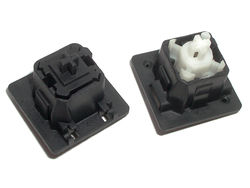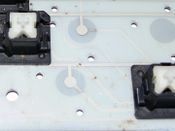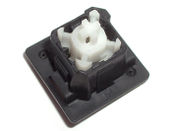Cherry MY
| This article requires additional photographic illustration — need photos of the other variants |
 | |
 | |
| Manufacturer | Cherry |
|---|---|
| Switch type | Linear |
| Sense method | Spring over membrane |
| Rated lifetime | 50 M |
| Preload | 20 cN |
| Actuation force | 60 cN |
| Peak force | ca. 110 cN |
| Pretravel | ca. 2 mm |
| Total travel | 4 mm |
| Keycap mount | Cherry MX mount |
| Patents |
EP0157035 (1984) EP0233926 (1986) US4800245 (1987) |
Cherry MY (AKA Cherry FTSC technology) is a spring-over-membrane keyboard switch series, serving as a cheaper alternative to their MX switch line.
Contents
Description
Cherry MY switches use discrete actuator modules over a three-layer membrane assembly; the membrane sheets are allegedly made of vinyl.[Citation needed] The switch technology is referred to by Cherry as "FTSC". A Cherry G81-1800 datasheet is one of the rare examples of "FTSC" being expanded to "Full-Travel Sealed Contact".
The earliest patent was filed in 1984, while the switch is claimed to have been introduced in 1987.[Citation needed] Since its introduction, three separate actuator designs have been encountered. Although all three appear to be very different, the basic construction is identical. The springs in all three appear to be identical; the changes appear to be solely to the design of the shell and slider.
Each actuator module contains two springs: a small helical return spring and a horizontal leaf spring that applies pressure to the membrane. The leaf spring serves as a motion reducer and functions similarly to prong over membrane switches by deflecting by a small amount in proportion to the force applied to the helical spring. The leaf spring is however operated directly by the slider; a bar that runs across the inside of the switch provides the post that locates the helical spring, and the helical spring does not come into contact with either the membranes or the leaf spring.
The base of the shell has been measured as approximately 18.7 mm square for Type 1, and approximately 18.8 mm square for Type 3. The shell height measures around 11.0 mm for Type 1, and around 10.8 mm for Type 3.
The leaf spring has two folds; one fold is approximately 90° and allows the spring to be pressed up into the shell. The other fold is very shallow and appears to be there to concentrate pressure onto the membrane assembly when the slider presses down on it.
The actuator modules are supported by the metal backplate behind the membrane assembly. Each module has two feet, each with three "toes". The feet push through holes in the membrane assembly, and small pegs are forced between the "toes" to push them apart and stop the actuator from being pulled out of the keyboard. The actuator modules thus rest directly on the top membrane sheet; as such, the leaf spring is only expected to move downwards a short direction, as the maximum travel of a membrane assembly is under 1/10th of a millimetre.
The slider can only be inserted in one orientation. Of the four grooves in the shell that guide the slider, one is wider, and the corresponding portion of the slider is wider to match.
Cherry's "The keyboard pros!" Catalog 06/07 provides the switch lifetime of 50 million keystrokes, and presents a force curve giving 20 cN preload, 60 cN actuation at just over 2 mm, and around 110 cN peak force; the extra 15 cN comes from the fact that the force curve is progressive rate, curving upwards just after actuation.
Keyfeel
The key feel will vary by type, with Type 1 switches seeming to be very smooth, while Type 2 and Type 3 do not exhibit anywhere near the same level of smoothness. None of the variants exhibit much audible friction. All 3 types exhibit the same behavior when bottoming out. When bottoming out a leaf spring is flexed by the slider which then presses down on the membrane assembly to close the switch. When this happens the short, flat portion of the leaf spring cannot be pushed downwards by the slider and so the long tail of the leaf spring flexes instead. It is this act of flexing the tail of the leaf spring that causes the bottom out of the switch to feel unusual. The unusual bottom out combined with the lack of smoothness displayed by Type 2 and Type 3 (which are by far the most common types) has led to generally negative opinions around this switch.
Prior research, now lost, indicated that the preload is 30 cN and the terminal force is 120 cN, compared to 40 cN preload and 90 cN terminal force of Cherry MX Black. A head-to-head press test of an MX Black switch against both a Type 1 and a Type 3 actuator module appears to confirm that the preload is lower than MX Black (the MY sliders give way first) but that the terminal force is higher (the MX slider soon starts to move faster than the MY slider).
Compared to Cherry MX it does not have as much friction when pressed straight down but it is actually worse on off-centre key presses.
Variants
The known variants are as follows:
| Type | Description | |
|---|---|---|
 |
Type 1 | Square black slider (no later than 1990) sometimes riveted to the plate instead of clipped — this is the original design as patented |
 |
Type 2 | Square white slider with triangular cutout[1] — very rarely encountered |
 |
Type 3 | White cylindrical slider (current version, produced since 1994 or earlier); presently the module part number is MY1A-21NC[2] |
Part MY1A-21NC is also referenced on KBDMania, suggesting that knowledge of it has at some point extended outside of Cherry, presumably for the purposes of ordering replacement parts.[3]
Disassembly
The slider is inserted into the shell from above. Two clips, one on either side, stop the slider from leaving the shell. To remove the slider, insert a long thin object against each clip and apply inward diagonal pressure (towards the centre of the slider); this will release the slider and push it out of the shell. To replace the slider, simply insert the spring and push the slider back into the switch. The leaf spring can be removed readily using tweezers.
Keyboards
See also Keyboards with Cherry MY switches.
- Cherry G81 series keyboards (all types)
- Later Acorn BBC Master Series Microcomputer production (not the Compact) — Type 3
- Some Olivetti KBD 2812
- Triumph Adler Gabriele 7007L — Type 1[4]
Gallery
Type 1
The depicted switches are from an unknown keyboard. Note that the feet have been sliced off.
Type 2
Type 3
Modifications
The helical spring can be removed, resulting in an extremely light switch, actuating at around 20–25 cN.[5] The switch retains its full travel after this modification.
Keycap compatibility with Cherry MX
Cherry MY switches have chiefly been used in Cherry G81 series keyboards. The biggest reason for buying one of these keyboards might be to harvest the keycaps and put them on a modern board with Cherry MX switches.
Stabilisers are different for MX and MY switches. On MY switches, the stabilizer bar is directly attached to the switch, while in the MX series, each switch has a pair of individual stabilizer mounts.
On most MY boards made after 2001, all keycaps with stabilizers, including the space bar, Enter, Backspace, numeric keypad Enter etc. have their stabilizing hinges integrated in the keycaps themselves. They are, therefore, normally not compatible with Cherry MX switches.
A modern, stabilized MY keycap has legs. It will not mount onto a MX switch if there is a mounting plate or stabilizer mounts are present. However, in the very rare case that a wide MX key is PCB-mounted and does not have any stabilizer mount, then the legs on the keycap could provide more stability when bottoming out.
Later MY keycap with integrated stabiliser inserts, incompatible with Cherry MX switches
Compatible with most Cherry MX keyboards
- All keys that are 1×1 units large
- Tab (1.50 wide)
Will fit some keyboards
- Caps Lock will fit Cherry boards, but no keyboard where the stem is centred.
- 1.25 '\' (US-ANSI)
- 1.25 Left Shift (ISO)
- 1.75 wide Right Shift (Cherry G81-1800 to Cherry G80-1800, Steelseries 6GV2 or JIS layout)
- 1.5 wide Ctrl and Alt modifiers from/to keyboards without Windows keys
May fit an unusual layout
1.25 wide Ctrl, Alt, Windows and Menu keys from newer MY keyboards. These have the switch mount not in the centre, but shifted to the right.
References
- ↑ Deskthority — Goupil Cherry industrial keyboard G81-1236
- ↑ Correspondence with Cherry US, 2016-02-25
- ↑ KBDMania — G81-1800HQAUS 구입 원하시는 분은 참고하세요. (Japanese) Posted 2004-12-30. Retrieved 2024-03-07.
- ↑ Deskthority — Triumph Adler Gabriele 7007L (ES Layout) Posted 2013-02-18. Retrieved 2024-03-07.
- ↑ Geekhack — Making Cherry Reds out of your G81 Posted 2010-10-24. Retrieved 2024-03-07.












